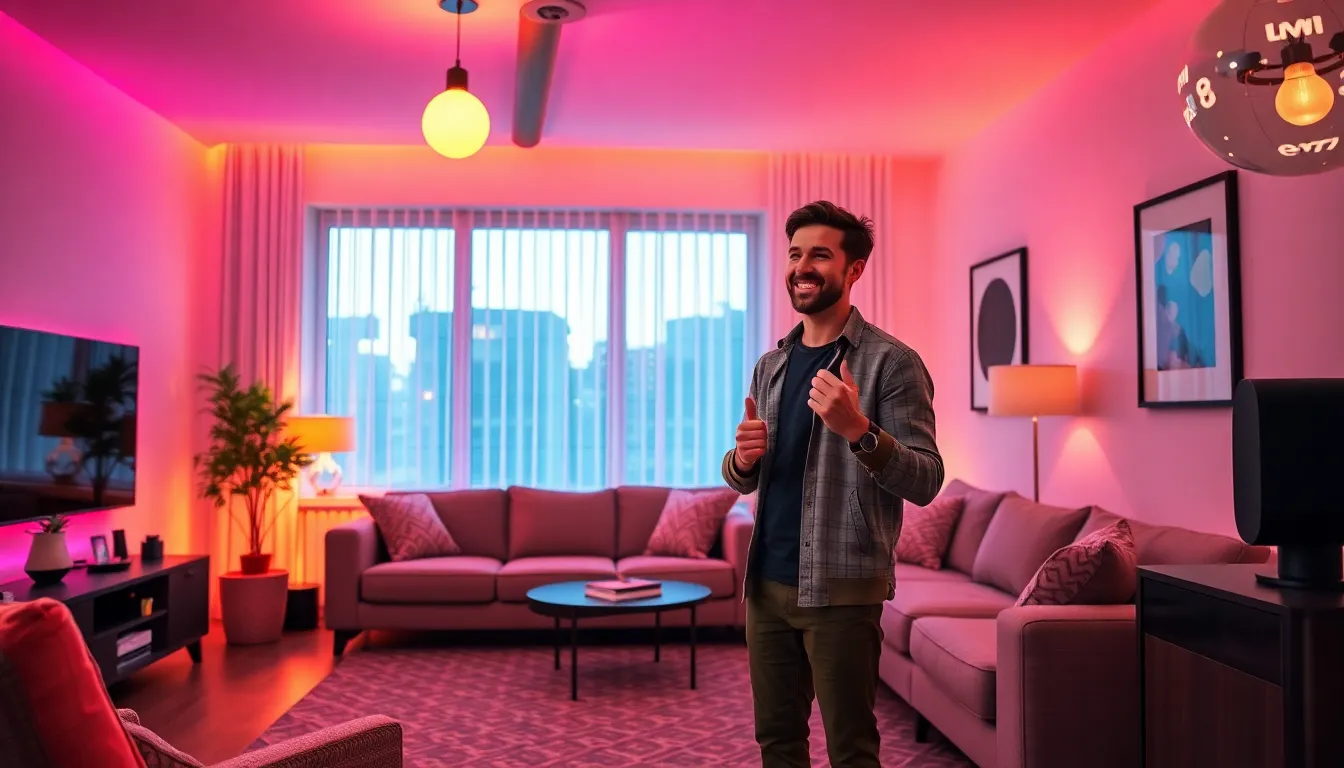Imagine walking into a room and with just a simple command, the lights flicker to life, illuminating your space like a scene from a sci-fi movie. Voice-controlled lighting isn’t just a futuristic dream; it’s a reality that’s transforming homes everywhere. Gone are the days of fumbling for switches in the dark or getting tangled in cords. Now, all it takes is a little shout to your smart assistant, and voilà—instant ambiance!
But it’s not just about convenience; it’s about creating an experience. Whether it’s setting the mood for a romantic dinner or lighting up the dance floor for an impromptu party, voice-controlled lighting adapts to every occasion. Join the revolution and discover how this tech marvel can brighten up your life—literally and figuratively. After all, who wouldn’t want to feel like a wizard casting spells with just a few words?
Table of Contents
ToggleWhat Is Voice-Controlled Lighting?
Voice-controlled lighting refers to a technology that allows individuals to control their home lights through voice commands. Devices integrated with this technology connect to smart assistants, such as Amazon Alexa, Google Assistant, or Apple Siri. Users can adjust brightness, change colors, or turn lights on and off simply by speaking.
Smart bulbs and light switches form the core of voice-controlled lighting systems. These products respond to specific commands like “turn on the living room lights” or “dim the bedroom lights.” Integration with smart home ecosystems enhances functionality, enabling users to create customized lighting scenes for different occasions.
Flexibility defines voice-controlled lighting systems. Homeowners can program schedules, set timers, or automate lighting based on routine activities. For example, lights can automatically turn on at sunset or off when individuals leave the house. Voice commands also simplify accessibility for those with mobility challenges, providing a hands-free lighting solution.
Customization plays a vital role. Users can personalize lighting settings to fit their mood or needs. For instance, they might choose warm tones for a cozy evening or vibrant colors for a lively party. Various manufacturers offer compatible options, allowing users to choose products that best fit their decor and preferences.
Voice-controlled lighting not only enhances convenience but also promotes energy efficiency. Smart systems track usage, helping users identify lighting habits and adjust as needed. This capability supports energy-saving practices and can lead to reduced electricity bills. Overall, voice-controlled lighting represents a significant advancement in home automation technology, creating smarter and more responsive living spaces.
Benefits of Voice-Controlled Lighting

Voice-controlled lighting offers various advantages, enhancing daily life through its functionality and features.
Convenience and Accessibility
Convenient operation defines voice-controlled lighting. Users no longer need to reach for switches; simple voice commands manage their home illumination. Accessibility improves, especially for individuals with limited mobility. Voice assistants enable effortless adjustments, from turning lights on and off to dimming and changing colors. Custom scenarios may even create specific moods for dinner parties or movies. This technology seamlessly integrates into smart homes, making lighting control a part of an overall automation system. Adjusting multiple lights simultaneously becomes easy, eliminating the cumbersome task of manual adjustments.
Energy Efficiency
Energy efficiency remains a key benefit of voice-controlled lighting. Smart systems track usage patterns, helping users identify how and when they use lights. Automations allow lights to turn off when spaces are unoccupied, reducing energy waste. Users may access real-time data showing consumption trends, encouraging energy-saving habits. Additionally, LED smart bulbs consume less power than traditional incandescent bulbs while offering more versatility. Monthly electricity bills often decrease as a result. Voice control fosters an eco-friendly approach to home management, promoting not just convenience but also sustainability.
How Voice-Controlled Lighting Works
Voice-controlled lighting utilizes smart technology to enable users to manage their home illumination through spoken commands. This system relies on smart bulbs and light switches that respond to specific inputs, allowing adjustments in brightness and color.
Integration with Smart Home Systems
Integrating voice-controlled lighting with smart home systems enhances overall functionality. Many users connect their lighting systems to hubs like Amazon Echo or Google Home, which serve as central control points. Automation features promote scheduling for lights to turn on or off based on users’ routines. Control over multiple devices occurs simultaneously, creating programmable scenes to match various occasions or moods. Such integration establishes a cohesive smart home environment, increasing convenience and efficiency.
Voice Assistants Compatibility
Voice-controlled lighting systems work seamlessly with popular voice assistants. Amazon Alexa, Google Assistant, and Apple Siri interact with smart devices, facilitating straightforward command execution. Users issue commands like “turn on the living room lights” or “dim the bedroom lights,” receiving immediate responses. Each assistant supports numerous compatible devices, expanding options for customization. Access to various applications enhances user experience, ensuring lighting fits their lifestyle perfectly.
Popular Voice-Controlled Lighting Solutions
Numerous voice-controlled lighting solutions dominate the market, each offering unique features that enhance user experiences. Philips Hue stands out due to its extensive range of smart bulbs, light strips, and fixtures compatible with popular voice assistants like Amazon Alexa and Google Assistant. With customizable colors and adjustable brightness levels, Philips Hue addresses varied user preferences seamlessly.
LIFX presents another robust option, known for bright, vibrant lights that don’t require a hub for connectivity. These bulbs connect directly to Wi-Fi, facilitating simple installation and use. Users can control multiple lights individually or as a group, making it easy to create the desired atmosphere.
TP-Link Kasa Smart Bulbs provide a cost-effective approach to voice-controlled lighting. These bulbs offer reliable performance while integrating smoothly with Google Assistant and Amazon Alexa. Scheduling features enable them to turn on and off according to user preferences, contributing to energy savings.
Sylvania Smart+ combines affordability with functionality, featuring a selection of bulbs and light fixtures that work seamlessly with Apple HomeKit, Google Assistant, and Amazon Alexa. The option to set scenes allows users to personalize their home environments effortlessly.
Ring Smart Lighting enhances security alongside convenience, integrating motion sensors with voice-controlled features. These lights can alert users when motion is detected, blending functionality with safety.
Smart switches, such as those from Wemo, empower users to control existing lighting without the need to replace bulbs. These switches integrate with major voice assistants, offering a way to transform standard lights into smart lights seamlessly.
Each of these solutions showcases the growing importance of flexibility, energy efficiency, and user-friendliness in smart home technology. As voice-controlled lighting continues to evolve, more options will likely emerge, enhancing daily living experiences for users across the globe.
Considerations When Choosing Voice-Controlled Lighting
Choosing voice-controlled lighting involves multiple considerations that can greatly impact user experience. Compatibility with existing smart home systems ranks high on the list. Users must ensure their chosen lighting products integrate seamlessly with platforms like Amazon Alexa, Google Assistant, or Apple Siri.
Energy efficiency also plays a crucial role. Many voice-controlled systems utilize LED technology, which consumes less power and lowers electricity bills. Cost should be analyzed carefully. While some options may present initial savings, long-term operational costs often matter more.
Control options influence ease of use. Some solutions offer advanced features like dimming or color adjustment, while others may focus solely on basic on/off functions. Durability is another consideration. The lifespan of smart bulbs can affect value, so choosing products with long-lasting components is wise.
Installation process varies among products. Some systems require professional setup, while others are user-friendly and allow for self-installation. Customization features attract many users. The ability to create specific lighting scenes enhances usability and personalizes the environment.
Availability of customer support is critical too. Reliable assistance can provide peace of mind. Reviews and ratings from other users can highlight which products perform best and meet expectations. Warranties and return policies aid in protecting investments.
Lastly, aesthetic preference should not be overlooked. Different designs and colors can complement home decor. Balancing functionality, energy efficiency, and appearance ensures satisfaction with chosen voice-controlled lighting solutions.
Voice-controlled lighting is revolutionizing how individuals interact with their home environments. This technology not only simplifies lighting management but also enhances the overall living experience. As it continues to evolve, users can expect even more innovative features that cater to their preferences and needs.
The integration of voice-controlled systems into smart homes promotes energy efficiency and convenience, making it an attractive option for many households. With a variety of products available, finding the right solution tailored to specific lifestyles is more accessible than ever. Embracing this technology can lead to a more sustainable and enjoyable home atmosphere.



